Hierarchical Bi2S3 nanothorn on ZnO core-branch photoelectrode: A promising heterostructure for enhanced photoelectrochemical water splitting
IF 2.4
4区 物理与天体物理
Q3 MATERIALS SCIENCE, MULTIDISCIPLINARY
引用次数: 0
Abstract
The zinc oxide semiconductor associated with defects and their recombination effect restricts the development of photoelectrode for hydrogen evolution. The combination of semiconductor hetero-junction and hierarchical interface of ZnO/Bi2S3 photoelectrode fabricated. In this study, heterostructure ZnO/Bi2S3 were studied as a photoanode with their impact of oxygen vacancy in ZnO nano rods. The trace of the Bi2S3 on the ZnO was studied and compared with pristine and oxygen annealed ZnO nano rods. The photon-luminescence studies reveal that shallow donor and acceptor defect in ZnO and restricted by Bi2S3 heterostructure. The less defect contemplations in the photoanodes accelerates up electron and hole migration leading to significant built-in potential and photocurrent generation. The appropriate method has been followed to architype less interfacial defect in ZnO(300)/Bi2S3 photoanode and boosted the photo-redox reactions for efficient hydrogen evolution. The photoanode exhibits substantial properties of photocurrent density 0.33 mA/cm2, charge transfer resistance of 700 Ω cm2 and higher inbuilt potential of −0.88V vs Ag/AgCl with 0.17 % applied bias photon to electron conversion efficiency and 0.11 % solar to hydrogen conversion efficiency.

ZnO 核支光电电极上的分层 Bi2S3 纳米刺:用于增强光电化学水分离的前景广阔的异质结构
氧化锌半导体的缺陷及其重组效应限制了氢气进化光电极的发展。结合半导体异质结和 ZnO/Bi2S3 光电极的分层界面,制造出了 ZnO/Bi2S3 光电极。在这项研究中,研究了异质结构 ZnO/Bi2S3 作为光阳极与 ZnO 纳米棒中氧空位的影响。研究了 Bi2S3 在 ZnO 上的痕迹,并与原始 ZnO 纳米棒和氧退火 ZnO 纳米棒进行了比较。光子发光研究表明,氧化锌中的供体和受体缺陷较浅,并受到 Bi2S3 异质结构的限制。光阳极中较少的缺陷可加速电子和空穴迁移,从而产生显著的内置电势和光电流。我们采用适当的方法在 ZnO(300)/Bi2S3 光阳极中形成了较少的界面缺陷,促进了光氧化还原反应,实现了高效的氢气进化。该光电阳极的光电流密度为 0.33 mA/cm2,电荷转移电阻为 700 Ω cm2,与 Ag/AgCl 相比,内置电位为-0.88V,外加偏压光子到电子的转换效率为 0.17%,太阳能到氢气的转换效率为 0.11%。
本文章由计算机程序翻译,如有差异,请以英文原文为准。
求助全文
约1分钟内获得全文
求助全文
来源期刊

Current Applied Physics
物理-材料科学:综合
CiteScore
4.80
自引率
0.00%
发文量
213
审稿时长
33 days
期刊介绍:
Current Applied Physics (Curr. Appl. Phys.) is a monthly published international journal covering all the fields of applied science investigating the physics of the advanced materials for future applications.
Other areas covered: Experimental and theoretical aspects of advanced materials and devices dealing with synthesis or structural chemistry, physical and electronic properties, photonics, engineering applications, and uniquely pertinent measurement or analytical techniques.
Current Applied Physics, published since 2001, covers physics, chemistry and materials science, including bio-materials, with their engineering aspects. It is a truly interdisciplinary journal opening a forum for scientists of all related fields, a unique point of the journal discriminating it from other worldwide and/or Pacific Rim applied physics journals.
Regular research papers, letters and review articles with contents meeting the scope of the journal will be considered for publication after peer review.
The Journal is owned by the Korean Physical Society.
 求助内容:
求助内容: 应助结果提醒方式:
应助结果提醒方式:


